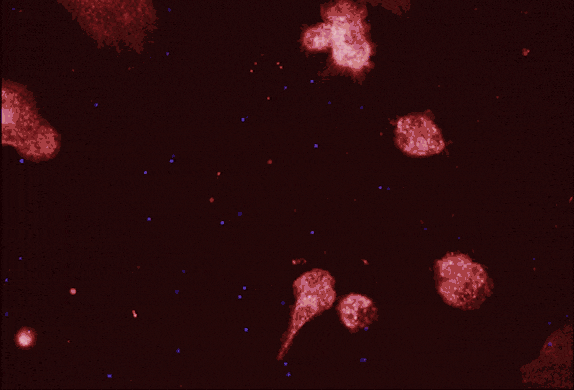Hungry, Hungry Macrophages (video)

Macrophages, the human immune system’s horde of cells that clear the body’s detritus by eating it, may be induced to gorge — in the name of helping combat Alzheimer’s and other diseases.
Macrophages have an appetite for destruction. (Their name means “big eater” in Greek.) As the immune system’s primary phagocyte — or cell that has the astounding ability to engulf and digest another particle — macrophages are, among other things, the human body’s primary cleanup system. They exist in every tissue. Every second of every minute of every day, millions of cells are dying all over our body, adding up to billions of dead cells by day’s end. So all that detritus doesn’t build up and bog down normal functioning, macrophages enter the scene. They surround the dead cells, digest them using enzymes, and leave the area a cleaner place.
The dead cells themselves send out what scientists call the “Eat Me” signal. They release chemicals that simultaneously attract macrophages and open up spaces in between blood vessel cells for the macrophages to squeeze through to get to the site of need.
Watch here as real-life macrophages ingest beads carrying the “Eat Me” markers.
Appetite for Alzheimer’s?
A macrophage is by its nature malleable. It is able to adapt to any tissue, able to ingest most any sort of dead cell or foreign intruder, from bacteria to viruses to parasites. Scientists are looking at ways to optimize that adaptability and channel it.
One potential target is the accumulation of a damaging, sticky protein called amyloid in the brain. Another is misfolded proteins called tau. It’s thought that the buildup of amyloid and tangles of tau are some of the causes of Alzheimer’s disease.
If a macrophage’s drive to eat damaged cells and other detritus could be harnessed and honed in on a specific target — plaque buildup or tau proteins, for example — and its ability to migrate could be directed to the interior of the brain, the macrophage could become an intracellular force in Alzheimer’s treatment.
—Johnna Rizzo
All original macrophage footage created by Regis Doyonnas, a specialist in cytometry at Pfizer’s Groton, Connecticut site. Part of Doyonnas’ team’s work focuses on the disease-fighting potential of macrophages.
